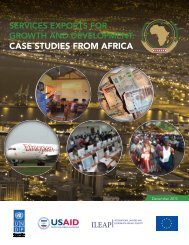BUDGET
budget
budget
Create successful ePaper yourself
Turn your PDF publications into a flip-book with our unique Google optimized e-Paper software.
THE <strong>BUDGET</strong> FOR FISCAL YEAR 2017 53<br />
they need to help them achieve their goals. To<br />
date, the President has designated 13 Promise<br />
Zones, and seven more will be announced in<br />
2016. The Budget supports all 20 Promise Zones<br />
through intensive, tailored Federal assistance at<br />
the local level. The Budget continues to propose<br />
Promise Zone tax incentives to stimulate growth<br />
and investments in targeted communities, such<br />
as tax credits for hiring workers and incentives<br />
for capital investment within the Zones.<br />
The Budget further supports efforts to<br />
transform distressed communities by expanding<br />
the Department of Education’s Promise<br />
Neighborhoods program and the Department<br />
of Housing and Urban Development’s (HUD)<br />
Choice Neighborhoods program. These programs<br />
have already provided critical funding for comprehensive<br />
and community-driven approaches<br />
to improving the educational and life outcomes<br />
of residents in over 100 distressed communities.<br />
The Budget provides $128 million for Promise<br />
Neighborhoods and $200 million for Choice<br />
Neighborhoods, an overall increase of $130<br />
million over 2016 enacted levels for the two programs.<br />
This additional funding would support<br />
implementation grants for approximately 15<br />
new Promise Neighborhoods and six new Choice<br />
Neighborhoods, and numerous other planning<br />
grants for communities to engage with stakeholders<br />
to create plans for future revitalization.<br />
To support private-sector partnerships and investments<br />
that play a key role in strengthening<br />
communities, the President also proposed to expand<br />
and make permanent the New Markets Tax<br />
Credit, which promotes investments in low-income<br />
communities. Under legislation signed<br />
into law by President Obama in December, $3.5<br />
billion in New Markets Tax Credits will be available<br />
annually through 2019. The Budget would<br />
make the program permanent with an annual<br />
allocation of $5 billion.<br />
HOUSING AND HOMELESSNESS<br />
Improving Mobility with Housing<br />
Choice Vouchers. In addition to the studies<br />
mentioned above related to the impact of<br />
poverty on families and children new research<br />
demonstrates moving to higher-opportunity<br />
areas with a rental subsidy can generate large<br />
benefits for children’s long-term earnings and<br />
educational attainment, especially for young<br />
children. These findings have significant policy<br />
implications. Though we must continue to<br />
prioritize revitalizing distressed communities,<br />
this research demonstrates the need to also<br />
invest in and make improvements to HUD’s<br />
Housing Choice Voucher (HCV) program,<br />
which provides rental assistance to over 2.2<br />
million extremely low- to very low-income<br />
households to enable them to rent modest<br />
units in the private market. The goal of the<br />
HCV program is not only to make decent, safe<br />
and sanitary housing affordable for low-income<br />
families, but also to improve the ability<br />
of families to rent in safer neighborhoods with<br />
more jobs and better schools.<br />
The President proposes $20.9 billion for<br />
the HCV program in 2017, an increase of $1.2<br />
billion over the 2016 enacted level, to expand<br />
opportunities for very low-income families. This<br />
includes additional funding for Public Housing<br />
Authorities’ (PHAs) to ensure they have sufficient<br />
resources to promote mobility and greater<br />
access to opportunity, as well as cover fundamental<br />
functions, such as housing quality inspections<br />
and tenant income certifications.<br />
In addition, the Budget requests $15 million<br />
for a new mobility counseling pilot designed to<br />
help HUD-assisted families move to and stay in<br />
higher-opportunity neighborhoods. These funds<br />
will be distributed to about 10 regional housing<br />
program sites with participating PHAs and/<br />
or private non-profits over a three-year period<br />
to provide outreach to landlords and counseling<br />
to voucher recipients on the benefits of<br />
opportunity-rich, low-poverty neighborhoods, as<br />
well as facilitate regional collaboration. A portion<br />
of the funding would also support an evaluation




